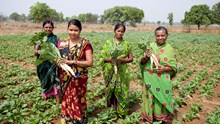
Chekurmanis is botanically known as Sauropus androgynus. It is a less common but extremely potent leafy green vegetable native to Southeast Asia. It is called Chekurmanis in Kerala, Multivitamin Saag in Hindi, and Madhura Cheera in Tamil in India. It is a multigreen traditionally grown in home gardens and is now gaining attention as a commercial crop due to its various advantages. It is a perennial crop which means that it continues to produce leaves every year, so it is a one-time cost for ongoing returns.
Farmers who have grown prior say that Chekurmanis is not only a crop, but also a companion that provides good health, regular yields, and a green environment. It is perfect for home gardens, organic farms, as well as terrace farming.
A Multivitamin on Your Plate
Chekurmanis has an extremely high nutritional value, it is what makes it apart. It contains protein which makes it one of the few leafy vegetables that can sustain vegetarian protein consumption. The leaves are full of Vitamin A, Vitamin B, Vitamin C, iron, calcium, phosphorus, and dietary fibre. These contribute to enhancing eyesight, increasing immunity, enhancing digestion, and developing bones.
The leaves are so full of nutrients that in most nations it is referred to as the "multivitamin green." The protein in Chekurmanis is close to that in some pulses and makes it a valuable addition to rural diets where protein deficiency is common.
How to Grow Chekurmanis
Chekurmanis is a low maintenance plant that thrives in hot and humid conditions, and hence it is suitable for the majority of India. It can be cultivated in soil with plenty of organic matter, but good drainage and moderate watering. Partial sun is preferred by the plant but can tolerate the full sun.
It is mostly propagated through stem cuttings which means there is no need for seeds to cultivate it. Farmers can simply cut 6- to 8-inch-long stems and plant them in damp soil. The stems will form roots and grow within 2 to 3 weeks. After that, the plant only needs light watering and occasional trimming to encourage new leafy growth.
This crop is cultivated throughout the year, but it grows optimally during the monsoon and winter seasons. As pests rarely attack Chekurmanis, it is well adapted for organic farming and chemical-free cultivation.
This crop can be grown all year round, but it thrives best during the monsoon and cooler months. Since pests rarely attack Chekurmanis, it is highly suited for organic farming and chemical-free cultivation.
Harvest and Yield
One of the biggest advantages of growing Chekurmanis is that it provides perpetual yields. The plant can be picked every 15 to 20 days after it reaches maturity, and leaves can be produced from a single plant for 3 to 5 years. For a small-scale farmer, even 100 plants can provide a constant supply of fresh greens for local markets, hotels, and vegetable shops.
The leaves are marketed fresh and possess a good shelf life if properly stored. In some areas, farmers have started selling Chekurmanis leaves as organic multivitamin greens, which fetch premium prices. As it involves minimal investment and possesses nearly zero input cost after plantation, it provides high returns to small and marginal farmers.
Tasty and Healthy
Chekurmanis is not only nutritious, but it also tastes great. The leaves are slightly spinach-flavored and can be added to curries, stir-fries, dals, soups, and chutneys. In Kerala and Tamil Nadu, the leaves are sautéed with coconut and spices to form traditional side dishes. In Thailand and Malaysia, it is usually sautéed with eggs or added to noodles.
Children and elders in the household can benefit from its high iron and vitamin benefits, and even a small serving a day can be of nutritional health. By adding this into your farm and kitchen, you are not only cultivating food but cultivating good health as well.
A Plant for the Future
As India move towards local food systems and sustainable agriculture, Chekurmanis perfectly serves the vision. It is ideal for food security, enhances nutrition, needs negligible care and water. It even thrives well without any chemical fertilizers. For farmers looking for crop diversification, adding their vegetables with something healthy, or creating a kitchen garden, Chekurmanis is the ideal choice.
Several farmer-producer associations and self-help groups have begun cultivating and selling Chekurmanis in bunches or processed products such as dried leaves and powders. Such value-added products create new markets and sources of income.
Chekurmanis is a gift from nature that is waiting to be embraced by Indian farmers. It represents simplicity, sustainability, and good health. Whether you're an agribusiness owner, small farmer, or backyard gardener, this leafy green can bring you both pride and financial gain. Growing Chekurmanis is a way to plant a better future in addition to a vegetable.
















